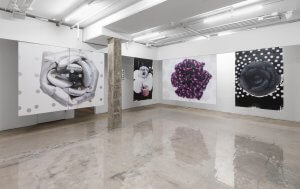Lorenza Longhi: World of Yum Yum | Brooklyn Rail
Mar 06 2024

By Jenny Wu
In her first US solo show, Lorenza Longhi casts a harsh fluorescent light on the fantasy-cloaked interiors of department stores. The exhibition takes its title, World of Yum Yum, from the essay “Glamour Wounds” by Rhonda Lieberman, in which the phrase is given as a moniker to the Chanel boutique where the writer suffers a vivid anxiety attack. “The symbolic efficacy of the staff and products as mocking accusers was such that I couldn’t have felt worse if Coco or Karl Lagerfeld himself were there looking at me,” Lieberman narrates, mid-spiral. “I was shocked that I could be so viscerally besieged by mere products and functionaries, who were in fact ignoring me.” At Swiss Institute, Longhi, a Zürich-based artist with a penchant for USM furniture, the lobbies of buildings, and the nuances of warm and cool lighting, takes up this figure of the commodity’s indifferent and controlling gaze, but instead of resigning the viewer to the cheap illusions that fuel paranoid consumption or the spectacle of consumerism in a time of economic inequality and climate crisis, she submits the objects of our collective desire to rigorous, impartial interrogation.
Spy cameras and flowers are the dual subjects of eight inked and wood-mounted digital prints suspended from the ceiling about five feet off the walls. Some of the higher-definition prints, such as Riot of Lace (all works 2024), which features a flower knitted from tricolor yarn with a beady-eyed camera in lieu of a pistil, and The Obsessions, a large, felted perennial with its aggressively magenta petals split across two panels, offer a near-haptic surplus of visual stimulation. Star, the portrait of a dark lens on a long stem stuck in a can of Hello Kitty-brand lemonade, evokes a sense of three-dimensional space only to disrupt it with a layer of ink. Eyeballs, two panels featuring a grid of flower-cams outlined in silver, calls to mind Andy Warhol’s high-contrast flower paintings of the 1960s.
Longhi’s Off-Season series, four box-shaped wall assemblages containing speakers veiled in rumpled florist paper, provide a soundscape for the gallery and the adjacent hallway and stairs. According to the press release, Longhi recorded the audio by taking her spy camera’s microphone to department stores in Zürich and New York. Taura Lamb’s “New Normal,” Desire’s “Tears from Heaven,” both the Prince and Sinéad O’Connor versions of “Nothing Compares 2 U,” and Taco’s “Puttin’ on the Ritz” feature among the sampled tracks. Reduced to surface and sound, the store’s powers of persuasion are neutralized. What Longhi’s works attend to instead are the codes of surveillance and control that we’ve internalized, replicating the affective intensities of the store without its distracting particularities.
For a show in Rome in 2020, Longhi used plastic film and cables to make an overhead installation, a drop ceiling that concealed part of the exhibition space’s original architecture. At Swiss Institute, she again incorporates an architectural addition, this time a makeshift frieze. White on one side and lined with patterned craft paper on the other, the “frieze” is fastened with silver tape to the apparatus holding up the wooden panels, hiding part of the metallic rigging. This subtle intervention formally inscribes the division between the exhibition’s center ring, where the viewer is “besieged” by stimulus in every direction, and a peripheral refuge, a backstage area where they see just the bare wood of the panels, having symbolically opted out of the arena of capitalist consumption. Considered another way, the viewer, first presented with the backs of the panels, had the choice all along not to opt in.
Beyond deconstructing the potentially alienating cultural experience of shopping, Longhi demonstrates a form of resistance through her methodology. With her spy camera, Longhi participates in sousveillance, a term coined by Canadian engineer Steve Mann to describe acts of “watching from below.” Traditional, top-down surveillance endows those whom Lieberman calls “functionaries”—security guards, salespeople—watching over shoppers and suspected shoplifters with at times panoptic access. Hierarchy-reversing sousveillance, according to Mann, instead resembles “shoppers photographing shopkeepers.” Although the stakes of recording the pop songs that play in a department store are arguably lower than those of wiretapping or leaking state secrets, the fact that Longhi can so happily marry retail and espionage in this exhibition signals something amiss in the boutiques, malls, and plazas where our intimate desires go to mingle with everyone else’s. The “world of yum-yum” in Lieberman’s essay may operate overtly as a space of exclusion, but the entire arena of capitalist fantasy and desire, where the shopper is a humble guest and a perpetual transient, just as readily enforces proliferating codes of acceptability one sometimes violates simply by existing. In her essay, Lieberman quips that we ought to heal our wounds by possessing and fusing with the hostile commodity. “Buy it, if possible,” she writes, to which Longhi’s show says, “Spy on it, if not.”
